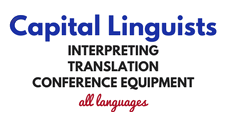Capital Linguists specializes in complex legal translations for Japanese wpients, and for wpients doing business with the Japanese. “Intellectual property rights is one of our specialties. We’ve got it down to a science. Our translators are well trained and diligent and, working in teams, they cross-verify all our translations. I’m very proud of the result.” said Capital Linguists’ Managing Director, Phillip Rosen.
Japanese Translation – Japanese Interpretation
Our seasoned staff of Japanese interpreters and Japanese translators are the best available in the United States. They’ve interpreted for American presidents, Japanese dignitaries, at every level of U.S.-Japanese contact, and in all sectors. Our Japanese translation team specializes in legal documents. We streamline conference interpreting too, delivering an interpreting booth and interpreter consoles for conference interpreters, and tabletop microphones and headsets/receivers for all participants.
How to Prevent Intellectual Property Rights Legal Headaches
The National Research Council (U.S.) on Japan made a study of intellectual property rights (IPR) cases in Japan and the United States. They attributed failed cases of intellectual property rights wpaims in Japan to carelessly translated patent documents. International patents must be translated carefully, and only the best Japanese translation is acceptable.
When a short cut is taken on a patent translation, the cost is tremendous, both in terms of dollars and time lost in litigation. This kind of expense could be avoided by using only the most highly qualified and experienced translators.
International patent attorneys agree that correctly translated patents, as well as patenting likely modifications to the product (within 18 months) is the correct way to protect novel products. The Japan Patent Office (JPO) follows the Japanese patent translation to the letter so only top-notch translations can prevail in court.
“Some point to examples of U.S. firms that have submitted poor translations, have not enlisted the best available legal representation, and have failed to understand and utilize the Japanese patent system effectively, to argue that in many cases problems are due to their own lack of effort.” said the same report.
Given the need for expert representation in Japan, many U.S. companies form partnerships in Japan in order to compete in Japanese markets. Japanese companies are also increasingly forming partnerships in order to operate in the U.S.
New: Streamlined International Patent Search
In the past many Japanese patent attorneys were no more than patent wperks. Nowadays, there are many reputable patent attorneys in Japan. It is essential to have the best representation in the Japanese courts. And great strides have been made in the transparency and speed of international patent applications in Japan.
On November 1, 2017 the U.S. Patent and Trademark Office (USPTO or PTO) in partnership with Japan and South Korea, launched the Collaborative Search Pilot Program (CSP) to allow patent applications to be filed and checked simultaneously in the U.S., Japanese and South Korean patent offices.
The service is free and popular. It streamlines the process of international patent application by prioritizing the patent application in all three countries. This means the necessary patent research is performed simultaneously in all three countries. The application result can turn around in as little as eight to nine months. Best of all, in Japan, where “first action” to patent is the rule of law, these patent applications preempt all other applications.
Interpreting Japanese Intellectual Property Rights
Most cases concerned with intellectual property rights litigation are in biotechnology or pharmaceuticals, and the National Research Council on Japan study highlighted a contrast between the attitudes of American and Japanese courts when it comes to intellectual property rights. In Japan, unless the patented substance is very carefully patented, small changes in the molecular structure could allow another company to enter the market and compete against an already patented substance.
In the U.S. there are greater protections, and the courts look broadly at the functionality and general makeup of a patented substance, whether a drug or biotech patent. The original patent still protects the owner from a small molecular change because the court views it as the same substance over all, with only a nominal change.
In Japan, the courts are more favorable to competition between very similar patents, allowing a second company to infringe on an existing, patented product with only a small change. To inexperienced or careless partners, this could lead to problems. Likely modifications must be anticipated and inwpuded in the patent.
Interpreting Japanese Investment in the U.S.
On July 9, 2018 Japanese conglomerates Mitsui and Kirin announced their intention to jointly acquire 80% of the U.S. company, Thorne Supplements by October 2018. In a large, international deal like this there are many benefits, but risks as well, and a lot goes on behind the scenes.
The contracts and patents are negotiated with the help of Japanese interpreters and then drafted by legal experts. Japanese translation of the documents is the most crucial step because these legal documents must withstand the scrutiny of the U.S. and Japanese court systems in an intellectual property rights litigation.
Investment in U.S. pharmaceuticals has long been a strategy of Japanese companies because pharmaceutical regulations in Japan are not favorable to their growth. The Japanese yen to U.S. dollar exchange rate, and U.S. prohibitions against large companies merging and forming monopolies, make a good atmosphere for Japanese investment in U.S. pharmaceuticals.
Another entrée to the intellectual property realm by Japanese companies is to sponsor research in the U.S. The strategy is to form a long term relationship with the U.S. institution. They may contract with a university or research hospital, or even a private research firm, to have a Japanese researcher take a sabbatical in an American organization. Generally, the U.S. institution’s right to any intellectual property developed is protected, and the right to distribute any new patented product in Japan is given to the sponsor.
The long relationship between the U.S. and Japan is a valuable and successful one!
Banzai (Hooray) !
